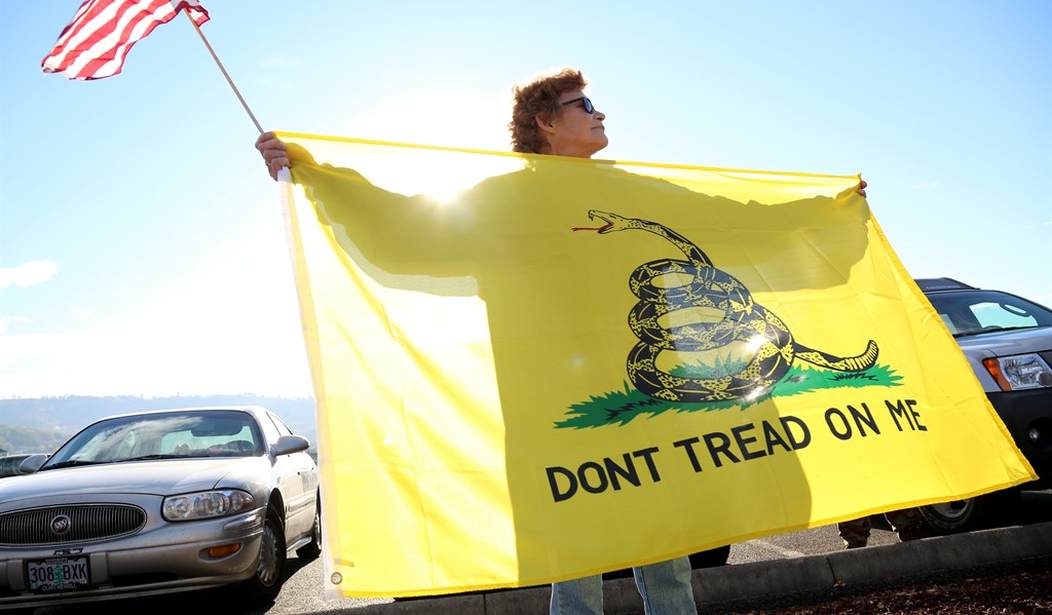A schoolboy has become an instant internet legend for defying a school district.
The 12-year-old has, as is so often the case, a bunch of patches on his backpack as an expression of his individuality. His school didn’t like one of the patches and demanded that he quit displaying it.
Was it a swastika? A picture of Mao? Or, gasp!, a portrait of Jesus?
No, it was the Gadsden flag, one of the most famous symbols from the Revolutionary War. The famous flag with a coiled snake on a yellow background mirrored Benjamin Franklin’s similar symbol of a snake emblazoned with the slogan “Unite or Die;” the Gadsden flag famously uses the slogan “Don’t Tread on Me.”
They cited @USEEOC, which admitted that the flag "originated in the Revolutionary War in a non-racial context"…
But then said "However, whatever the historic origins and meaning of the symbol, it also has since been sometimes interpreted to convey racially-tinged messages…" pic.twitter.com/w0M74bMgN2
— Connor Boyack 📚 (@cboyack) August 29, 2023
The school claimed that the flag is a symbol of slavery and White Supremacy, and perhaps by their lights, it is. After all, EVERYTHING American is a symbol of White Supremacy if you buy into CRT, which is why asshole athletes kneel during the national anthem.
Public schools, though, typically display the American flag and are government-funded, and each of those teachers and administrators is taking a salary partially funded by the state, and partially by the federal government. Unless they are all White Supremacists then their contention that the Gadsden flag makes no sense. It was the most popular symbol of the Revolution.
The director then argued that the flag is associated with "hate groups," linking to this weak article that cites a "graphic design scholar" 😂 who claimed that "some may now see the Gadsden flag as a symbol of intolerance and hate—or even racism."
Link: https://t.co/ZD6JZ4AhDK pic.twitter.com/sUOqLEwGf0
— Connor Boyack 📚 (@cboyack) August 29, 2023
The reality is much simpler: our education “professionals” are simply too ignorant to know anything as complex as American history, so they just assume that anything older than 1960 is all about slavery or something. I would wager (seriously, I would) that a majority of non-history teachers could not name the year in which the Civil War began, no less anything as ancient as the meaning of the Gadsden flag.
What percentage of public school teachers could name the year the Constitution was written? I’d bet half or more would answer “1776.”
School district: @HarrisonSD2
School: https://t.co/rynpBvy7Vz (no Twitter/X account)
Director: Jeff Yocum, [email protected]
— Connor Boyack 📚 (@cboyack) August 29, 2023
Schools do have some rights to restrict speech for students, but that right is not unlimited. Yet it is almost unlimited.
The issue of school speech or curricular speech as it relates to the First Amendment to the United States Constitution has been the center of controversy and litigation since the mid-20th century. The First Amendment’s guarantee of freedom of speech applies to students in the public schools. In the landmark decision Tinker v. Des Moines Independent Community School District, the U.S. Supreme Court formally recognized that students do not “shed their constitutional rights to freedom of speech or expression at the schoolhouse gate”.[1]
The core principles of Tinker remain unaltered, but are clarified by several important decisions, including Bethel School District v. Fraser, Hazelwood School District v. Kuhlmeier, Morse v. Frederick, and Mahanoy Area School District v. B.L.[2][3] Despite respect for the legitimate educational interests of school officials, the Supreme Court has not abandoned Tinker; it continues to recognize the basis precept of Tinker that viewpoint-specific speech restrictions are an egregious violation of the First Amendment.[2] In Rosenberger v. Rector and Visitors of the University of Virginia, the Supreme Court declared: “Discrimination against speech because of its message is presumed to be unconstitutional”. Rosenberger held that denial of funds to a student organization on the sole basis that the funds were used to publish a religiously oriented student newspaper was an unconstitutional violation of the right of free speech guaranteed by the First Amendment. Accordingly, for other on-campus speech that is neither obscene, vulgar, lewd, indecent, or plainly offensive under Fraser nor school-sponsored under Hazelwood nor advocating illegal drugs at a school-sponsored event under Frederick, Tinker applies limiting the authority of schools to regulate the speech, whether on or off-campus, unless it would materially and substantially disrupt classwork and discipline in the school.
This is why the school administrators argued that the flag was associated with prohibited things like drugs, alcohol, or weapons. No marijuana leaf flags, I guess.

It’s all BS though. What the Gadsden flag does represent is defiance of arbitrary authority, which is absolutely appropriate in this case.
The flag is available as government-issued license plates in a number of states, including Florida (of course), and has become a bete noire for many liberals, who do indeed claim it is racist for some reason. The EEOC actually investigated the issue a while back and debunked the claim, although liberals persist in making it because they hate anybody who doesn’t immediately submit to authority.
That, ultimately, is what this fight is about: authoritarians vs. freedom. The Gadsden flag is a symbol of freedom and defiance, neither of which the Left can abide (except when it comes to sexual matters, which are sacrosanct). These school officials likely know nothing about the origins or meaning of the flag, but the intellectuals who are attacking it sure do.
Freedom must be crushed, and nothing inspires like a symbol around which people can rally.








Join the conversation as a VIP Member